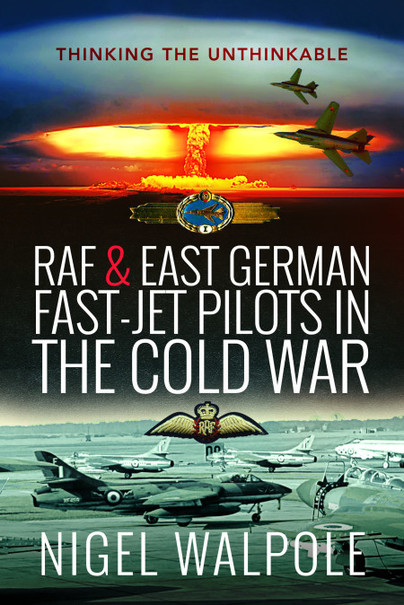Author Guest Post: Nigel Walpole
COMPARING THE LIVES OF RAF AND EAST GERMAN PILOTS IN THE COLD WAR
My wife held up the barbed wire for me to crawl under and into the once highly secret Warsaw Pact airfield at Zerbst, in East Germany, which in the Cold War had thundered to the sound of Russian fighter-bombers, and so was a target of interest to me as a NATO fast-jet pilot. Now a sinister silence pervaded the deserted guard posts, crumbling runways and rusting hangars; it was 1998, and the Cold War was over.
Back in November 1955 I had been posted to RAF Oldenburg, one of many WW2 Luftwaffe stations in West Germany resurrected for our use in NATO, and by Christmas I was patrolling the Inner German Border (IGB) in a brand new Hunter fighter, highly manoeuvrable, capable of supersonic speeds, and with its four 30mm guns loaded. By then, the RAF had more than 20 fighter/fighter ground-attack squadrons in North Germany, as part of the Second Allied Tactical Air Force, comprising Dutch and Belgian Air Forces, a USAF component and the embryo West German Air Force. We were there primarily to deter the Soviet Air Force and the fledgling East German Air Force of the Nationale Volksarmee (NVA) from any aggressive act, and at high level we were able to watch each other over the IGB, practicing formation, tactical manoeuvres and simulated combat.
I spent 14 years of that ‘war’ serving on the front line in North Germany, flying air defence fighters, armed reconnaissance and nuclear armed fighter-bombers, or on supporting staffs. We had of course heard a great deal about the capabilities of the Warsaw Pact forces, their numerical superiority and their command and control system, from numerous intelligence briefings – but was it all true? Now, with the collapse of the Soviet Union, the Russian occupation ended and Germany reunified, I was able to check this out with our one time adversaries, the East German pilots, and to walk that once forbidden ground. It was soon apparent that while we had, perforce, much in common as military aviators, there were major differences in the way we lived our lives at work and play, but with much of the evidence anecdotal, and political issues hovering, many questions remain unanswered.
Typically, we drew comfort from the well worn theme that NVA fast-jet pilots generally flew only 10 hours a month, whereas we regularly flew 20 – therefore we must be ‘better’! However, I found that all their sorties were planned and rehearsed meticulously, with every minute committed constructively, monitored and debriefed extensively, the flight times recorded to the minute, and we cannot claim that this was always true in NATO training.
The claim that the Warsaw Pact’s command and control system was unwieldy and might collapse under pressure also remains unproven. In documents and anecdotally, I found that good, flexible use was made of its massive redundancy in radar warning and control facilities, with innovation and individual initiatives among commanders, controllers and pilots to cope with the unexpected in an ECM environment. This I weighed against 2ATAF’s heavy dependency on four very visible and highly vulnerable Master Radar Stations (MRS).
I’m glad that we didn’t go to war.

Preorder a copy of RAF & East German Fast-Jet Pilots in the Cold War here.

